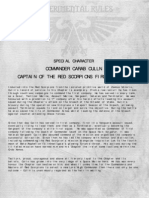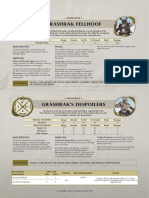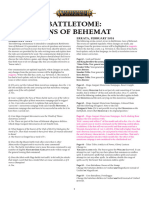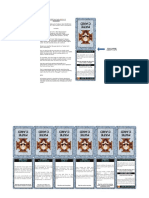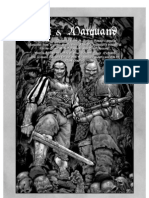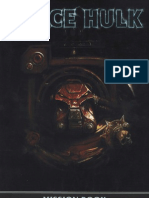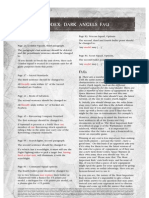Zone Mortal Is
Zone Mortal Is
Uploaded by
alxndrmlrCopyright:
Available Formats
Zone Mortal Is
Zone Mortal Is
Uploaded by
alxndrmlrCopyright
Available Formats
Share this document
Did you find this document useful?
Is this content inappropriate?
Copyright:
Available Formats
Zone Mortal Is
Zone Mortal Is
Uploaded by
alxndrmlrCopyright:
Available Formats
DEADLY CLOSE-QUARTER BATTLES IN THE LABYRINTHS AND VAULTS OF THE 41ST MILLENNIUM
The following rules expansion for Warhammer 40,000 deals with some of the most savage arenas of combat conceivable, the battleelds the Codex Tactica Imperialis refers to as Zone Mortalis the fatal ground. Such zones be they the contested decks of a void warship, tangled mine works, lightless underhives, the prison-vaults of sundered fortress citadels, labyrinthine industrial sewer systems and sacred catacombs, all have a conuence of factors in common such as close-connement, limited access for attack or escape routes, as well as treacherous environments, which make them murderous venues for warfare. These rules offer the chance to ght desperate battles of your own on such deadly ground and draw heavily upon the Zone Mortalis rules previously published in Imperial Armour Volume 9: The Badab War Part One, and the feedback we have had from players. Like those rules, Zone Mortalis battles are also unashamedly designed to be fatal and chaotic affairs, as ghting in a collapsing hive city under mass artillery bombardment or on a burning star vessel in the middle of a space battle ought to be! Its the kind of game where all sorts of odd situations are going to be thrown up from time to time and sudden reversals will occur, so have fun with it hypercompetitive players or those seeking complete predictability in their games will be better served elsewhere. It is of course no coincidence that this Zone Mortalis expansion has been prepared in concert with the release of Forge Worlds new Realm of Battle Complex terrain, which is perfect for representing the narrow connes and twists and turns of the Zone Mortalis battleeld, but of course such battles are not limited purely to using this terrain. In fact any suitably tangled and conned battleeld such as can be formed using the illustrated tile board from Games Workshops Space Hulk game, closely packed Necromunda scenery or an endless variety of terrain of your own devising can be used in conjunction with this rules expansion. THE TWO MODES OF ZONE MORTALIS PLAY The Zone Mortalis rules have two modes of play. The rst and simplest mode is to incorporate a designated area of Zone Mortalis terrain in a regular game of Warhammer 40,000. This makes a proportion of the gaming table operate under the basic Zone Mortalis rules and can represent the internal space of a command bunker, trench network, generatorium or xeno-lab, or perhaps even a temple to the Chaos Gods where a dark ritual is underway. This can simply be used to divide up the gaming table in a unique and interesting way, or provide an exciting locale to place scenario objectives as a focus for a narrative game. The second mode of play is to use the Zone Mortalis rules in missions of their own, where the entire gaming table is made up of the deadly and close-packed Zone Mortalis terrain. In these games the forces involved are selected from special Force Organisation charts and have access to a number of optional special rules to create a unique and unpredictable battle.
ZONE MORTALIS
BOARDING ACTIONS The star vessels of the 41st Millennium range in size and scope from small interplanetary shuttles, to mighty battleships with crews numbering in the thousands. Even larger than these are the Chartist High Conveyers tens of kilometres in length and drifting space hulks, unfathomably ancient and alien, that dwarf even these. In the case of these larger vessels and space stations, regardless of whether they are an engine of war or a merchant hauler, their sheer size grants them weaknesses to be exploited in battle. Damage done to specic vital regions inside them can be as fatal to those inside as poison injected into a living heart. The best way of doing this is often by breaching the hull of an enemy vessel and successfully assaulting it with troops. If they are victorious then this can allow the ship to be crippled, captured intact or even destroyed from within. Only the most skilled and able attackers are selected to undertake boarding assaults and attrition among them is always frighteningly high, but great is the glory gained should they succeed. The shipboard defenders who repel a boarding assault must ght with all the courage and ferocity they can muster if they are to save their ship. For the loser in these battles death is certain, as aboard a star vessel surrounded by the innite darkness of the cold and silent void, there is nowhere to retreat or run to.
ZONE MORTALIS TERRAIN IN WARHAMMER 40,000 BATTLE MISSIONS
DESIGNATING THE TERRAIN All Zone Mortalis terrain should be designated as such during the games set-up and agreed between the players. Any area of Zone Mortalis terrain should have a clear boundary edge if part of a larger battleeld, and it should have clear entry points where units can gain access. BULKHEAD DOORS & AIRLOCKS Chambers and corridors may be sealed off by the use of armoured bulkhead doors and airlocks. Depending on the mission youre playing these doors may be locked, accessible or controlled. These doors should be represented on the table and moved to show whether they are open or closed at any given time. A closed bulkhead door blocks line of sight and assaults may not be made through them. Locked: A locked door is inaccessible except by destroying it or forcing or overcoming the lock in some way. In most cases only direct force will do (although particular missions will offer alternates to this). Once a bulkhead door has been destroyed, remove it from play. Accessible: An accessible door may be either opened or closed by the rst unit that moves into contact with it in a particular turn, allowing a unit to pass through it, or shut it behind them. A bulkhead door may only be used once per turn (either opened or closed), but may be destroyed at any time. Controlled: In the case of a particular door or doors being controlled by one side in the game (as might commonly be the case where one side represents a force defending the Zone Mortalis area from an attacker), the side which controls the doors treats them as accessible by their units, but units belonging to other forces treat them as being locked. Destroying Doors: Bulkhead doors and airlocks are armoured and reinforced structures and therefore difcult to destroy. Unless noted otherwise in a scenario, all bulkhead doors and airlocks are treated as being Armour Value 13, and require a single glancing or penetrating hit to destroy.
OTHER ZONE MORTALIS SPECIAL RULES
DEADLY GROUND Fighting within Zone Mortalis terrain is a dangerous and treacherous affair, and one in which even light vehicles can ounder or damage themselves, unexpectedly crashing through buckled deck plating, getting crushed beneath falling rubble, or contacting exposed power conduits with deadly results. Only a model that can physically t within the space on the tabletop can move through or into a Zone Mortalis, regardless of its type. This is a common sense distinction which must be followed. In addition the following effects apply by unit type: Bikes, Jetbikes, Artillery and Walkers treat all difcult terrain they encounter within a Zone Mortalis as dangerous terrain as well. Should any of these use a turbo boost, they must take a Dangerous Terrain test regardless of the ground they cover. This overrides any normal rules they possess to the contrary. All models classed as Jump Infantry which move more than 6" in the Movement phase must take a Dangerous Terrain test every time they do so. All other vehicles, including Skimmers, treat a Zone Mortalis as both difcult and dangerous terrain in its entirety. Infantry, Monstrous Creatures and Beasts treat Zone Mortalis as they would any other battleeld, i.e. where specic areas of difcult and dangerous terrain are encountered, they are subject to their effects, otherwise the Zone Mortalis is treated as clear ground. Wrecked vehicles are both difcult and dangerous terrain if destroyed in Zone Mortalis areas.
RESERVES AND DEEP STRIKING The rules for Reserves, Scouts and Inltrators remain unchanged (unless otherwise stated by a specic mission description), but entrance and exit points are still the only way these units can enter the Zone Mortalis. Only units which are described as being able to teleport or materialise from the Warp may use the Deep Strike special rules. Any unit that deep strikes into a bulkhead suffers a Deep Strike mishap this makes deepstriking into a Zone Mortalis a dangerous proposition! Barrage weapons cannot be used to re indirectly within, into, or out of Zone Mortalis areas at all; only direct re can be used. FIRESTORM & SHRAPNEL The conned spaces of the Zone Mortalis can prove to be death traps to the unwary and certain types of weapons have their effectiveness increased by the environment, while others become more unpredictable. Weapons with blast markers and templates may re-roll failed rolls to wound inside the connes of a Zone Mortalis, reecting the lethal effect of explosives, aming liquid and shrapnel in connement. Additionally, if a Scatter roll takes a blast markers centre point into contact with a bulkhead wall, it detonates on contact with the wall; resolve the weapons effect from this spot. The portion of the blast that crosses and lies beyond the line of the wall is lost. NOWHERE TO HIDE Units that break and ee from combat within the connes of a Zone Mortalis are far more likely than in most games of Warhammer 40,000 to be trapped in areas where their avenues of retreat are entirely cut off, and due to the confusion of corridors and passageways that may surround them, falling back may be a particularly deadly affair. Contrary to the usual rules for falling back, immediately on failing a Morale test, a units rst fall back move is directly away from the enemy, and subsequent moves are towards the nearest exit unblocked by the presence of enemy models. If a unit is trapped while falling back by enemy models and cannot escape, then it is immediately destroyed. Blind Panic: If while falling back a unit moves through (i.e.within 1" of) another of the players own units, the unit moved through must take an immediate Morale test or fall back themselves. Fearless units are not subject to this. OBJECTIVES IN ZONE MORTALIS GAMES These are generally assumed to be treated as impassable terrain and do not block line of sight. In addition, in order to claim or contest them an eligible unit must have a model in base contact with the objective, unless specied in a particular mission.
FIGHTING A ZONE MORTALIS BATTLE
The following section offers a variety of optional rules and mission types for playing games of Warhammer 40,000 using only Zone Mortalis terrain, conducting deadly battles and close-quarter actions such as boarding actions, xeno-eradications and desperate tunnel ghts. Most Zone Mortalis missions must have an Attacker and a Defender. Which player takes which side must be decided before play. This may be done by mutual agreement or by rolling off and the winner picking which they will be. Because Zone Mortalis actions are fought in quite dense terrain, and without the assistance of transport vehicles to get around, a smaller gaming area can often improve the experience of play. As such it is recommended that a 4' x 4' area is used for games of 1,000 pts a side or less (which will offer an exciting battle lasting an hour or two), while larger tables are best used as part of team games. Forces selected for ghting in a Zone Mortalis action should be chosen from their codex as normal with the following exceptions: Units may not select Dedicated Transport options. No unit may have a starting size greater than 10 models, before being joined by Independent Characters. Vehicles other than Walkers may not be chosen unless their models are no more than 4" wide.* Monstrous Creatures needing more than a 60mm round base may not be chosen.* *Note: The terrain may still conne you, so caveat emptor!
ADDITIONAL SPECIAL RULES
The following are a number of optional special rules for use in your games of Zone Mortalis. The use of any or all of these optional Zone Mortalis special rules should be agreed on before play. ATTRITION (OPTIONAL) Attrition is a special rule which reects the bloody nature of a Zone Mortalis conict and affects the conditions of victory. Whenever a mission result is for any reason a draw, then the force which suffered the least number of destroyed units is considered the victor. CATASTROPHIC DAMAGE BURIED ALIVE! (OPTIONAL) One of the perils of battle underground or within a building is the risk of bringing the roof down on yourself and being buried alive or crushed under tonnes of earth or masonry. These effects are represented in the game by the Catastrophic Damage Buried Alive! table. When this special rule is in effect, every turn after the rst each player should roll a D6 at the beginning of the turn, add the scores together and apply the results on the following chart. In addition if any ordnance weapon has been used on the preceding turn add +1 to the total. Note that this special rule brings a hugely unpredictable (and enjoyably dangerous) element to your games, and should be treated as such. This rule should not be used in conjunction with Catastrophic Damage Void Ships & Stations. CATASTROPHIC DAMAGE TABLE BURIED ALIVE! D6 2-4 4-7 8-9 10-11 12+ Result Stable no effect Look Out! Tremor Cave-in Quake!
FORCE SELECTION
Each force should be selected using the following Force Organisation chart for Zone Mortalis battles: ATTACKER:
HQ
ELITES
FAST ATTACK
TROOPS
HEAVY SUPPORT
DEFENDER:
HQ
ELITES
FAST ATTACK
TROOPS
HEAVY SUPPORT
COMBATANT: (Neither side is the specied Attacker or Defender)
HQ
ELITES
FAST ATTACK
TROOPS
HEAVY SUPPORT
Look Out!: The players roll off, and the winner may place a single 5" template anywhere on the table to represent a sudden deadfall. Roll for scatter just as for an indirect re weapon. Any model caught under the template suffers a Strength 5 AP 4 hit. Units with an armour value are struck on their rear armour. Tremor: The ground shakes dangerously, walls shiver and dust billows down in choking clouds. All clear terrain counts as difcult terrain for this turn only. Cave-in: The players roll off, and the winner may place D3 5" templates anywhere on the table to represent a cave-in. Roll for scatter just as for an indirect re barrage. Any model caught under each template suffers a Strength 5 AP 4 hit and must take a Barrage Pinning check. Units with an armour value are struck on their rear armour. Quake!: Every model on the table must pass a Strength test or be removed as a casualty. Models without a Strength score are automatically destroyed (buried under tonnes of rubble or earth), and independent characters may re-roll this test if failed. If a 12+ is rolled again, treat this as having no effect. ENEMY UNKNOWN (OPTIONAL) While the Night Fighting rules as presented in the Warhammer 40,000 rule book represent ghting in levels of low visibility over distance, this can be nothing compared to the abyssal darkness of ghting deep underground or within the tortuous connes of a space hulk, where even the nest auguries and sensors may prove utterly useless. The confusion of this kind of ghting can be represented by using counters on the table to represent units outside of visual range of the enemy rather than models, as the enemys true disposition and strength will remain unknown until your forces are face-to-face in battle. The use of this optional special rule requires a little more work than usual and co-operation between the players, but can make for very nervewracking and exciting games. Each side requires a set of numbered counters (or blips) sufcient for the number of units it has in its force. Each number must correspond to a particular unit within their force, and which this is must be noted down before the game begins. It is these counters that are deployed rather than the units on the table. As the game progresses, the blip counters are moved in place of units until they move within line of sight of an enemy unit or the unit engages in shooting or close combat attacks. At this time the unit is revealed and the note showing the number and its corresponding unit is shown to the opposing player. The counter is then replaced with the corresponding unit, which is deployed in coherency with its centre where the counter was when revealed. If on subsequent turns a unit that has revealed itself passes out of line of sight of the opposing forces models, it is once more replaced with its corresponding numbered counter (and its up to the enemy to remember what it was until it becomes visible again!). Independent characters which join units do not have a blip counter of their own while they are with a unit, but this fact must always be noted down to avoid confusion or chicanery!
REACTION FIRE (OPTIONAL) The conned spaces of a Zone Mortalis make for deadly, close range re-ghts, where a split second reaction may be enough to gun down an enemy rushing out from the darkness before death strikes you down. In order to represent this, this special rule allows units being assaulted a chance to re their shooting weapons when they are assaulted if theyre fast enough! Only units not already engaged in close combat may attempt reaction re. Only pistol, assault and rapid re weapons may be used for reaction re attacks. Heavy weapons may only be used for reaction re attacks if the model carrying them has the Relentless special rule. A unit may only make a single reaction re attack against the rst unit they are assaulted by in any given turn. A reaction re attack is made after an assault is declared, but before assaulting models have moved. Casualties resulting from reaction re may cause an assault to fail. Making a Reaction Fire Attack: In order to make a reaction re attack, the unit in question must rst roll equal to or under its majority Initiative score on a D6. If successful it may re its weapons at the assaulting enemy, just as it would in the Shooting phase but at -1 BS (minimum BS 1). Template weapons are used as normal if the Initiative test is successful. A unit may not use the Counter Attack special rule if it has used reaction re. THE COLD VOID (OPTIONAL) One of the greatest dangers of ghting aboard the titanic star vessels of the 41st Millennium is the icy hand of the void itself, and while many battles will be fought behind sealed bulkheads and within pressurised sections, others will not, and be all the deadlier for it as a ripped suit or broken armour seal can quickly kill or disable their victim. This special rule can also be used to represent ghting in a Zone Mortalis lled with poisonous gas, choking industrial fumes or extreme heat. When the Cold Void special rule is in effect, the following apply: All weapons and attacks with a Strength of 4 or higher now cause the Rending effect, unless their target is Void Hardened, has an armour value (AV) or has a save of 2+. In the case of attacks against mixed units, apply these rending wounds to the more vulnerable targets rst. All weapons and attacks which already have the Rending effect now rend on a roll of 5 or 6, unless their target is Void Hardened, has an armour value (AV) or has a save of 2+. In the case of attacks against mixed units, apply these rending wounds to the more vulnerable targets rst. Weapons and attacks which have the Blast special rule also now cause pinning if they didnt already.
CATASTROPHIC DAMAGE VOID SHIPS & STATIONS (OPTIONAL)
Most boarding actions take place amid the backdrop of erce space battles in which immensely destructive forces quite beyond the combatants control are unleashed that may even destroy the very ship over which they ght. Even when the boarded ship is not taking direct hits in the battle, the effects of prior damage can cause secondary explosions to rip through its hull, and the vessel itself may be caught in a crossre, or ride through the blast waves of dying ships and lethally spinning debris. These effects are represented in the game by the Void Ship Catastrophic Damage table. When the Catastrophic Damage special rule is in effect, each player should roll a D6 at the beginning of each game turn, the results of these rolls are added together and the results on the following table apply for this turn: CATASTROPHIC DAMAGE VOID SHIP TABLE D6 Result 2-3 Hull Quake 4-5 Power Surge 6-9 No Effect 10-11 Wildre 12 Structural Collapse!
No Effect: Although the hull creaks and moans and the distant thunder of explosions can be heard, the effect is not strong enough to play a part in the battle this turn. Power Surge: The ships energy systems go into violent spasm, blowing out lighting arrays and either plunging the area into darkness or ooding it with a blaze of sparks. If this result is rolled then the Night Fighting rules are in effect this turn (if they were already in effect they no longer apply this turn as a power surge unexpectedly res up the lights). Bulkheads: Additionally, if they are being used, bulkheads and airlock doors may either open or shut on their own on a D6 roll of 5+ (roll once separately for each one). Hull Quake: The ships hull bucks and shakes, and gravity uctuates wildly. All clear terrain is counted as difcult for this turn, and already existing difcult terrain is counted as both difcult and dangerous terrain for this turn. Wildre: A series of secondary explosions blanket the area of the battle as conduits erupt in ame, and areas of the deck plating collapse or are blown in. Divide the board into sectors as shown on the Catastrophic Damage diagram opposite. Roll D6+1 to see how many explosions occur in total. Randomise the location of the explosions, rolling a D6 and referring to the diagram to nd the starting point (with the 5 or 6 indicating the centre of the table), and then use the Scatter dice and 3D6 to determine where each one occurs. Explosions which scatter off the table are assumed to be lost. Place the large blast marker on the point where each explosion occurs. Any unit or model caught in the blast suffers a Strength 5 AP 5 Pinning attack. Structural Collapse! The hull screams and shudders before part of it catastrophically breaks apart, either blasting out air and debris into the beyond or shattering around the unfortunate combatants. Roll a D6 and consult the Catastrophic Damage diagram opposite to determine in what area the collapse occurs, if a 5 or 6 is rolled all areas are affected equally. All models with a Toughness score in the affected area suffer an immediate Strength 4 Rending hit, and models with an armour value (including special terrain and so on) suffer a glancing hit on a 4+. From this point on the Cold Void special rules are in effect for the rest of the battle if they were not previously.
CATASTROPHIC DAMAGE DIAGRAM
56
SAMPLE ZONE MORTALIS LAYOUTS
3' x 3'
6' x 4'
4' x 4'
4' x 4'
6' x 4'
THE ZONE MORTALIS ASSAULT MISSION
The following special mission represents a savage assault with command of a vital Zone Mortalis area at stake. One player or team of players take up the role of the Defenders and one opponent or team of players takes on the role of the Attackers. Table Set-up: The Zone Mortalis is a tangled labyrinth of passageways and chambers and should be represented appropriately. If you are using Forge Worlds Zone Mortalis Complex terrain boards, then they may be either laid out in an agreed fashion (see examples shown previously) or alternately the players may take turns placing boards so that they take up the playing area, making sure that each table edge has at least one clear entry/exit point per player. Objectives: Depending on the Mission Goal (see opposite), objectives may be used. In this case they should be represented by a model or marker on a 20mm base or a suitable alternative. Scoring Units: In the Zone Mortalis assault mission, units drawn from either the Troops or Elites allowance count as scoring units where this is called for by the mission. A unit may only ever claim one objective at a time. Ending the Game: The game has a variable game length as per a Standard Mission (see page 90 of the Warhammer 40,000 rulebook). Wipe-out!: Regardless of any other condition, if at the end of the game your enemy has no units left on the table then you are victorious! DEPLOYMENT Before the game begins, both sides should divide their forces into two roughly equal groups based on their number of units. They must then decide which of these two forces is to be their spearhead and which is to be their reserve. This arrangement represents an attacking force working its way through the Zone Mortalis, and the Defenders rallying to meet them. The gaming table is then divided into four quarters, and both players rolloff to choose a deployment zone. The winner then picks which is to be their deployment zone and deploys their spearhead force anywhere in this area, but not within 6" of the centre of the board. The other player then rolls a D6. On a roll of a 4+ they may choose any of the three remaining areas in which to deploy their spearhead, otherwise they must deploy their spearhead in the area opposite that of their opponent. Reserves arrive normally, entering the board from any table edge in their players deployment zone.
6"
FIRST TURN The player or side which deployed rst has the rst turn unless their opponent can steal the initiative. MISSION GOALS Before the game begins, either mutually agree or roll a D6 to determine the goal of the Zone Mortalis assault: D6 1-2 3-4 5-6 Result Search and Destroy Force the Breach! Sabotage
SEARCH AND DESTROY This mission represents the vicious struggle to control the Zone Mortalis through brute savagery and attrition, destroying the enemys forces in detail. Kill points are used to determine the victor, with one Kill point scored for each enemy unit, independent character or walker destroyed. At the end of the battle, the side with the highest tally of Kill points is the winner. FORCE THE BREACH! This represents the Defenders trying to maintain hold of a vital area of the Zone Mortalis, whilst the Attacker must wrest it from them. The Defender places three objectives: one in their own deployment zone and one in each of the zones in which neither player has deployed. These objectives may not be placed within impassable terrain, or less than 6" away from the table edge or the centre of the table. If the Attacker is in control of more objectives than the Defender at the end of the game they are the winner. If any other result is the case, the Defender is the winner. SABOTAGE The Attackers goal is to destroy vital systems within the Zone Motalis. The Defender places D3+2 sabotage objective markers on the table. These markers represent control panels and systems junctions vital to this area. The markers may be placed anywhere on the table other than within 6" of a table edge or 12" of each other. They also may not be placed in impassable terrain. The Attacker must attempt to destroy these objectives by any means they can. Each has an armour value of 11, and will be destroyed by any successful glancing hit or penetrating hit scored against them. Because their Attackers cannot be certain of destroying them properly at distance, these objectives count as having a 4+ Invulnerable save against any shooting attack or blast damage they suffer and cannot be harmed by events on the Catastrophic Damage table. At the end of the game, the Attackers gain 1 Victory point for each sabotage objective destroyed, and the Defenders 1 Victory point for each sabotage objective still on the table. The side with the most Victory points is the winner.
THE ZONE MORTALIS ENCOUNTER MISSION
The following special mission represents two hostile forces advancing through unknown ground where neither side has the advantage of foreknowledge or tactical control of the area. Both forces use the Combatant Force Organization chart for this mission. Table Set-up: The Zone Mortalis is a tangled labyrinth of passageways and chambers and should be represented appropriately. If you are using Forge Worlds Zone Mortalis Complex terrain boards, then they may be either laid out in an agreed fashion (see examples) or alternately the players may take turns placing boards so that they make up the playing area, making sure that each table edge has at least one clear entry/exit point per player. Objectives: Depending on the Mission Goal (see opposite), objectives may be used. In this case they should be represented by a model or marker on a 20mm base or a suitable alternative. Scoring Units: In the Zone Mortalis encounter mission, units drawn from either the Troops or Elites allowance count as scoring units where this is called for by the mission. A unit may only ever claim one objective at a time. Ending the Game: The game has a variable game length as per a standard mission (see page 90 of the Warhammer 40,000 rulebook). Wipe-out!: Regardless of any other condition, if at the end of the game your enemy has no units left on the table then you are victorious! DEPLOYMENT Before the game begins, both sides should divide their forces into two roughly equal groups based on their number of units. They must then decide which of these two forces is to be their spearhead and which is to be their reserve. This represents the larger force moving through the Zone Mortalis without knowledge of enemy contact. The players (or sides) roll off, the winner choosing which of the table edges is to be their deployment zone, and deploys their spearhead force within 6" of their table edge. Then their opponent deploys their spearhead force within 6" of the opposite table edge.
Deployment zone
6"
6"
6"
6"
Deployment zone
Deployment zone
Deployment zone
FIRST TURN The player or side which deployed rst has the rst turn unless their opponent can steal the initiative. MISSION GOALS Before the game begins, either mutually agree or roll a D6 to determine the goal of the Zone Mortalis encounter: D6 1-2 3-4 5-6 Result Search and Destroy Capture Ground Invasion
SEARCH AND DESTROY This mission represents the vicious struggle to control the Zone Mortalis through brute savagery and attrition, destroying the enemys forces in detail. Kill points are used to determine the victor, with one Kill point scored for each enemy unit, independent character or walker destroyed. At the end of the battle, the side with the highest tally of Kill points is the winner. CAPTURE GROUND The two forces must control the area of the Zone Mortalis and drive out the enemy. This mission goal uses ve objective counters. The rst of which is deployed as close to the centre of the table as possible, while each side places two additional objectives each anywhere on the table so long as they are not placed within impassable terrain, or less than 6" away from the table edge or within 6" of another objective. Control of the centre objective is worth 3 Victory points, whereas control of the other objectives is worth 1 Victory point each. The side in control of the most objectives at the end of the game wins. When playing on a larger table (such as a 6' x 4' Zone Mortalis), increase the number of objectives to seven. INVASION The two opposing forces seek to force their way into enemy held territory, slaughtering as many of the foe as possible. For every scoring unit within the enemy deployment zone at the end of the game, the owning player gains 3 Victory points. For every destroyed enemy unit, the player gains 1 Victory point. The player with the most Victory points at the end of the game wins.
You might also like
- Imperial Armour Volume 9 - Culln UpdateDocument2 pagesImperial Armour Volume 9 - Culln UpdatecrazycurlsNo ratings yet
- High Elves Teclis (High Magic) BSB - White Lions BoWD + Caradryan 2400 Pts. (Warhammer Fantasy 8th Ed) (2,399pts) - PagenumberDocument8 pagesHigh Elves Teclis (High Magic) BSB - White Lions BoWD + Caradryan 2400 Pts. (Warhammer Fantasy 8th Ed) (2,399pts) - PagenumberStefan Hogrefe100% (1)
- Zone Mortalis v1.1Document10 pagesZone Mortalis v1.1jNo ratings yet
- Badzone Delta-7: Cult Ritual Chamber Using These Rules On Sector Mechanicus BattlefieldsDocument17 pagesBadzone Delta-7: Cult Ritual Chamber Using These Rules On Sector Mechanicus BattlefieldsPaul Valinor100% (1)
- Warzone Eternal - Beta Rules Document - 091723Document60 pagesWarzone Eternal - Beta Rules Document - 091723igpsluveNo ratings yet
- Inside:: Issue 4 - February 2004 Bi-Monthly Warhammer E-ZineDocument40 pagesInside:: Issue 4 - February 2004 Bi-Monthly Warhammer E-ZineJoe BloggsNo ratings yet
- WHQ Character - War DancerDocument27 pagesWHQ Character - War DancerikmviiNo ratings yet
- EpicSpaceMarineBattles TitanGargantDataSheets-1Document5 pagesEpicSpaceMarineBattles TitanGargantDataSheets-1UlfieNo ratings yet
- Warhammer 8th Edition Rules Changes.Document5 pagesWarhammer 8th Edition Rules Changes.Dion EverettNo ratings yet
- RailRaidersInfiniteRuleBook KickstarterDocument12 pagesRailRaidersInfiniteRuleBook KickstarterHector CobachoNo ratings yet
- Space-Crusade Video Game ManualDocument25 pagesSpace-Crusade Video Game ManualChristian SchultzNo ratings yet
- The Cursed TowerDocument2 pagesThe Cursed TowerAndy KirkwoodNo ratings yet
- Aos Grashraks Despoilers en PDFDocument1 pageAos Grashraks Despoilers en PDFTuro SantikkoNo ratings yet
- Battletome Sons of BehematDocument1 pageBattletome Sons of BehematdopsoeNo ratings yet
- Lustria - Cities of GoldDocument87 pagesLustria - Cities of GoldKairoNo ratings yet
- Close Assault WeaponsDocument6 pagesClose Assault WeaponsRobLeeNo ratings yet
- White: White Dwarf Magazine What Have You Missed?Document1 pageWhite: White Dwarf Magazine What Have You Missed?BOlthonnNo ratings yet
- Games Workshops Warhammer Nemesis Crown Campaign HobbyDocument5 pagesGames Workshops Warhammer Nemesis Crown Campaign Hobbycbaconpalardes100% (1)
- E WarwagonDocument2 pagesE WarwagonSander Verhoeven100% (1)
- All and Intended. Cards Are Provided Free of Charge and Not For ResaleDocument9 pagesAll and Intended. Cards Are Provided Free of Charge and Not For ResaleDainXBNo ratings yet
- AoS 3 Reference Sheet 2.4Document13 pagesAoS 3 Reference Sheet 2.4AmarNo ratings yet
- Everquest Ii: 15 Ways To Play Better Right NowDocument21 pagesEverquest Ii: 15 Ways To Play Better Right NowMatt MilesNo ratings yet
- Brutal Doom ManualDocument29 pagesBrutal Doom ManualCristian ȘarpeNo ratings yet
- Warhammer 40k Blood Ravens LoreDocument25 pagesWarhammer 40k Blood Ravens LoreAlexandru Costescu100% (1)
- Introducing The New Fanatic MagazineDocument1 pageIntroducing The New Fanatic MagazineBOlthonnNo ratings yet
- Fanatic Magazine 07Document86 pagesFanatic Magazine 07Isidro Moriñigo100% (1)
- Alternating Activation For 40k Second EditionDocument2 pagesAlternating Activation For 40k Second EditionAlex CollinsNo ratings yet
- Alliance Format Rules: W D C BDocument2 pagesAlliance Format Rules: W D C Bthomasyss1986No ratings yet
- Mord Ulli and MarquandDocument5 pagesMord Ulli and MarquandLuciano MolinaNo ratings yet
- Another Boardgame Player Aid byDocument12 pagesAnother Boardgame Player Aid bypmdcoverNo ratings yet
- NecromundaDocument5 pagesNecromundaVedran PelivanovicNo ratings yet
- Data Sheet Eldar Phantom TitanDocument1 pageData Sheet Eldar Phantom Titanshootme2001No ratings yet
- WargearDocument69 pagesWargeartoggleknotNo ratings yet
- Horus Heresy General Errata and FAQ v1.1 Final PDFDocument28 pagesHorus Heresy General Errata and FAQ v1.1 Final PDFEnrique PeriamNo ratings yet
- AdMech FW V8 (Fires of Ceyaxus Fanmade) PDFDocument31 pagesAdMech FW V8 (Fires of Ceyaxus Fanmade) PDFhawkmoor100% (1)
- Wood Elves 8 ThenDocument64 pagesWood Elves 8 ThenAlex Rusakov100% (1)
- Rynn World CampaignDocument2 pagesRynn World CampaignWayne WilkinsonNo ratings yet
- AchillesDocument1 pageAchillesGeorge Neale100% (1)
- White Dwarf Supplement: Path of The Slayer MinigameDocument4 pagesWhite Dwarf Supplement: Path of The Slayer MinigameLich109No ratings yet
- Into The DarkDocument37 pagesInto The DarkMarcelo GuedesNo ratings yet
- Ork SubmersibleDocument1 pageOrk Submersiblegtc1981No ratings yet
- SH1 Missions SH3 StyleDocument100 pagesSH1 Missions SH3 Stylewrongplanet67100% (2)
- Nurgle Spell ListDocument2 pagesNurgle Spell ListwlexbshuzqpwbgqyamNo ratings yet
- Frozen Death ScenarioDocument2 pagesFrozen Death ScenarioHiveFleetEreVoS100% (2)
- DwarvesDocument25 pagesDwarvesLUIS ESTEBAN100% (1)
- Pts/model WS BS S T W I A LD SVDocument13 pagesPts/model WS BS S T W I A LD SVGraham Peacock100% (1)
- m1810079 Dark Angels Oct 2008 5th Edition FAQDocument3 pagesm1810079 Dark Angels Oct 2008 5th Edition FAQebfootball139No ratings yet
- The Prussian Army of Frederick the Great, 1740-1786: History, Organization and UniformsFrom EverandThe Prussian Army of Frederick the Great, 1740-1786: History, Organization and UniformsNo ratings yet
- Theatre of War Zone Mortalis 9th Edition 2.3Document24 pagesTheatre of War Zone Mortalis 9th Edition 2.3qqrfz4z9rhNo ratings yet
- 7th Ed Zone MortalisDocument15 pages7th Ed Zone Mortalisaaronschies31No ratings yet
- The Walls of JerichoDocument4 pagesThe Walls of Jericholord_mortisNo ratings yet
